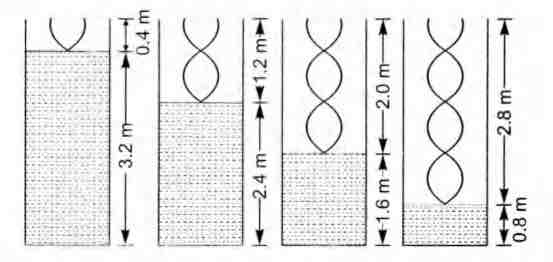Q.
A 3.6 m long pipe resonates with a source of frequency
212.5 Hz when water level is at certain heights in the pipe.
Find the heights of water level (from the bottom of the pipe)
at which resonances occur. Neglect end correction . Now the
pipe is filled to a height H ($\approx 3.6m). $ A small hole is drilled
very close to its bottom and water is allowed to leak. Obtain
an expression for the rate of fall of water level in the pipe as a
function of H. If the radii of the pipe and the hole are
$2 \times 10^{-2}m $ and $1 \times 10^{-3}m $ respectively. Calculate the time
interval between the occurrence of first two resonances.
Speed of sound in air is 340 m/s and g $=10m/s^2 $
IIT JEEIIT JEE 2000Waves
Solution:
Speed of sound v=340 m/s
Let $l_0 $ be the length of air column corresponding to the
fundamental frequency. Then,
$\frac {v}{4l_0}=212.5 \, or \, l_0= \frac {v}{4(212.5)}= \frac {340}{4(212.5)}=0.4 \, m $
In closed pipe only odd harmonics are obtained. Now let
$l_1,l_2,l_3,l_4, $ etc., be the lengths corresponding to the 3rd
harmonic, 4th harmonic, 7th harmonic etc. Then,
$\, \, \, \, 3 \bigg (\frac {v}{4l_1}\bigg )=212.5 \, \, \, \, \Rightarrow l_1=1.2 \, m $
$\, \, \, \, 5 \bigg (\frac {v}{4l_2}\bigg )=212.5 \, \, \, \, \Rightarrow l_2=2.0 \, m $
and $\, \, \, \, 7 \bigg (\frac {v}{4l_3}\bigg )=212.5 \, \, \, \, \Rightarrow l_3=2.8 \, m $
$\, \, \, \, 9 \bigg (\frac {v}{4l_4}\bigg )=212.5 \, \, \, \, \Rightarrow l_4=3.6 \, m $
or heights of water level are (3.6- 0.4) m, (3.6- 1.2) m,
(3.6- 20) m and (3.6- 28)m.
$\therefore $ Heights of water level are 3.2 m, 2.4m, 1.6m and 0.8 m.
Let A and a he the area of cross-sections of the pipe and hole
respectively. Then,
$\, \, \, A=\pi (2 \times 10^{-2})^2=1.26 \times 10^{-3} m^2 $
and $a= \pi (10^{-3})^2=3.14 \times 10^{-6}m^2 $
Velocity of efflux, v$= \sqrt {2gH} $
Continuity equation at 1 and 2 gives
$ a\sqrt {2gH}=A\bigg (\frac {-dH}{dt}\bigg ) $
$\therefore $ Rate of fall of water level in the pipe,
$ \bigg (\frac {-dH}{dt}\bigg )= \frac {a}{A}\sqrt {2gH} $
Substituting the values, we get
$ \frac {-dH}{dt}= \frac {3.14\times 10^{-6}}{1.26 \times 10^{-3}}\sqrt {2 \times 10 \times H} $
or $ \frac {-dH}{dt}= (1.11 \times 10^{-2})\sqrt H $
Between first two resonances, the water level falls from
3.2 m to 2.4 m.
$\therefore \frac {dH}{\sqrt H}=-(1.11 \times 10^{-2})dt $
or $\int _{3.2}^{2.4} \frac {dH}{\sqrt H}=-(1.11 \times 10^{-2}) \int _0^t dt $
or $2[\sqrt {2.4}- \sqrt {3.2}]=-(1.11 \times 10^{-2}).t $
or $ t\approx 43 \, s $
NOTE
Rate of fall of level at a height h is
$ \bigg (\frac {-dh}{dt}\bigg )= \frac {a}{A}\sqrt {2gh}\propto \sqrt h $
i.e. rate decreases as the height of water (or any other liquid)
decreases in the tank. That is why, the time required to empty the
first half of the tank is less than the time required to empty the rest
half of the tank.
